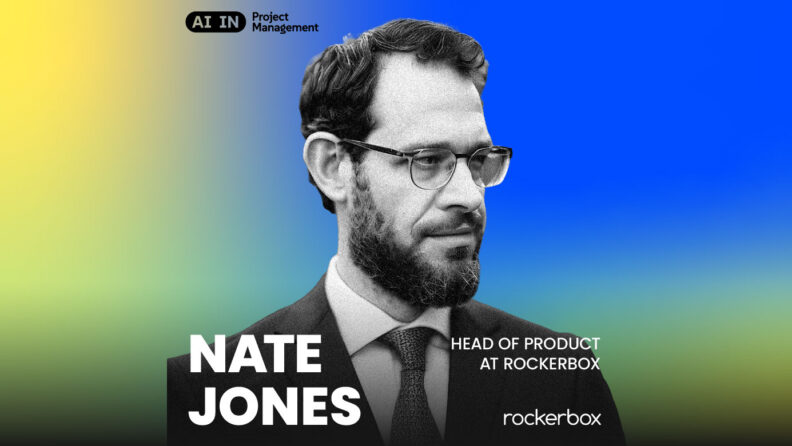Agentic workflows redefine project delivery: AI agents can now handle triage, planning, and documentation at scale. When paired with clear business rules, they dramatically increase speed and consistency across projects.
The new PM is a manager of agents: Product and project managers must shift from creating artifacts to validating agent outputs. The job now centers on oversight, quality control, and guiding AI systems to learn and improve.
Adopting AI requires deep operational change: Moving to AI-driven workflows isn’t plug-and-play. It demands new habits, clean context management, and clear documentation so humans can focus on the 2% of strategic work that drives the 98% executed by AI.
Here's what he told us.
Meet “The Mr. Rogers of AI” and his obsession with AI
I'm Nate — known around the internet as the guy in the beanie who talks about AI a lot. Someone called me "The Mr. Rogers of AI" recently and I kind of loved it. I came up through product management, so I'm very familiar with the challenges of delivery, and I work with companies that are working on delivering agentic AI systems.
In my opinion, the most important thing you can do right now is learn AI. That's why I teach it.
I obsess over it. And the people I know who are obsessing over it are the ones doing best in their careers. You have to look at fluency velocity — how quickly you’re improving your ability to use AI tools — as a core career metric.
How to 10x your efficiency and delivery speed with AI in 24 months
AI has changed everything! It has changed my role completely. I start with AI by default now.
In fact, I would say I've 10x'd my scope and speed of delivery while raising quality in the span of 24 months. Here's how you can do the same:
- Change your mindset: Default to LLMs first. That's the only way to learn.
- Expect deliverables, not just advice: AI is a powerful tool that can drive complete deliverables, especially in project management. You just need to push it to deliver. Hold a high-quality bar for it. Tell it bluntly when its output is not good enough. Then, look to yourself because the issue is almost always that you didn't clearly communicate intent, and the LLM is inferring from a vague prompt with unhelpful results.
- Use LLM-assisted prompt construction: LLMs can help you construct your prompts, and it is a huge time saver.
- Learn optimal LLM usage: Learn to split inputs and prompt very cleanly. And obsess over the inputs, data, and clean context that you feed the model.
How to automate ticket triage and task decomposition with agentic systems
Constructing ticket triage and decomposition at scale using agentic systems has been very important. Particularly for getting clean, typed, and declarative planning architectures and agent flows.
Here’s an agentic ticket triage workflow from end to end:
- A customer call gets transcribed with Granola (note taking app). The transcript then enters an agentic pipeline.
- The first agent uses GPT-5 Thinking to parse the transcript and identify the customer’s voice. It outputs clear asks.
- That output is passed to the next agent, which calls Notion (project management software) via MCP, logs the customer's info and asks, and attaches the full transcript for reference.
- The next agent invokes an analysis LLM, in my case, Gemini 2.5 Pro to scan the entire Notion database using a custom prompt. It comes back with a weighted view of ask priority across all known requests.
- Then, another agent uses a lightweight LLM (like GPT Turbo) to query Linear via MCP. It compares those priorities to existing tickets, identifies overlaps, and highlights any gaps.
- If there are gaps, the workflow loops back to GPT-5 Thinking with a prompt to generate product problems and solution requirements.
- Then, an agent calls ChatPRD via MCP to draft a product requirements document (PRD).
- After that, GPT-5 Non-thinking takes over to break the PRD down into individual tickets — a very linear step — and sends them back to Linear via MCP.
- Finally, if you want to go further, another agent can pull the roster of human and agentic developers (like Devin AI) and begin assigning tasks automatically in Slack.
Constructing ticket triage and decomposition at scale using agentic systems has been very important. Particularly for getting clean, typed, and declarative planning architectures and agent flows.
What agentic pipelines are and how to build them for scalable delivery
Agentic pipelines are an entire day of lessons on their own, but here's the gist of it: You are handing an LLM the tools, guidance, and scope to tackle a problem for you. Constructed via API, your goal is to pull relevant data in — e.g., via the MCP server off Atlassian or a similar system — and then pair incoming tickets with the correct prompting to initiate autonomous action.
This is where clean declarative prompting is important. I find that leaning less on prompt language works well, baking structure right into the workflow. This enables scale across different ticket types. Getting to deterministic intelligence — where outputs are consistent and predictable — by brute-forcing clarity and business rules into workflows scales to thousands of tickets.
Just look at the agentic flow I described above. It is not about prompting well. It has one or two prompts, but it's mostly business rules, returned data, and carefully structured reasoning tasks in small pieces. Big prompts for thinking models are not as dependable as lots of sequential tasks for dumb models. But it's important to note that you have to build in verification with dumb models.
Why adopting AI in delivery workflows takes serious change management
Overall, I've been surprised by how much work it takes to adopt AI in delivery workflows! It's a massive change management effort — probably the biggest we've seen in tech. You have to reorient your entire workflow around assuming the human provides 2% of the attention, while the LLM provides 98%.
The entire process of work has to be rebuilt.
What does moving toward that world look like? What's the right 2% of attention for the human so they get real leverage with that focus? How can you meaningfully 10x scope with the extra LLM attention? How do you rebuild templates, context expectations, documentation expectations, and process?
Think of it like this — your job in product is not to write artifacts now. It's to:
- Think about future direction
- Validate agentic systems that are starting to listen, construct PRDs for you, and pass them into dev.
- And actively get hands-on and intervene where you see better options.
So construct systems that let you review a flow of ideas that AI is starting to generate.
Similarly, in projects, the job of keeping the trains on the tracks isn't about artifacts or meetings. It's not stakeholder updates. It's looking at an automated flow like I describe above and saying, "Nope, I think there's a root estimate here that's incorrect," and then intervening and putting your hands on the work to ensure correctness — while also ensuring the system learns from that intervention.
You are a manager of agents now.
A look inside Nate Jones’ AI tech stack for building and managing projects
Here's a look at my stack for inspiration:
- Linear is a great choice for project management — built for AI
- Superhuman's AI (productivity software) features for searching, composing, and calendaring to simplify correspondence
- Granola for meeting transcripts
- Perplexity for research
- ChatGPT Deep Research for a first-pass look at complex topics
- GPT-5 Pro for very complex thinking and problem solving
- Codex for guided code problem solving
- Claude for wrestling with editing and composition
- Claude Code for a general-purpose agent with local file access
- Claude on mobile as a personal assistant
- Riverside for AI-powered recording
- Comet Browser for intelligently browsing the web with AI
And I'll say this: People overlook tool use for Claude. It can create Excel and PowerPoint from scratch. And you can use Claude Code for much more than coding. I actually wrote a whole article about that.
Why AI is killing meetings and enabling fully async collaboration
You can go much more async now, with AI. I've built whole products without a single meeting with my co-builders. You just get excellent documentation systems and handle decisions in Slack.
AI enables this with AI-powered documentation, AI-powered coding, and more.
But above all, it's about a mindset shift.
Why traditional project management is disappearing in the age of AI
Taste isn't going away. Neither is accountability. Or stakeholder management and relationships. Or non-determinate tasks with ambiguous context. You need humans for those.
But project management, as the practice of wrangling cats and pushing projects, is going to disappear. All of the keeping-trains-on-tracks stuff is going to get picked up by AI.
So my advice is to get excited about the ambiguous, human parts of the job. And start leaning really hard into building and managing AI agent systems — you can get started with OpenAI agent builder and n8n.
My advice is to get excited about the ambiguous, human parts of the job. And start leaning really hard into building and managing AI agent systems — you can get started with OpenAI agent builder and n8n.
Follow along
You can follow along and learn from Nate via his newsletter and YouTube.
More expert interviews to come on The Digital Project Manager.




